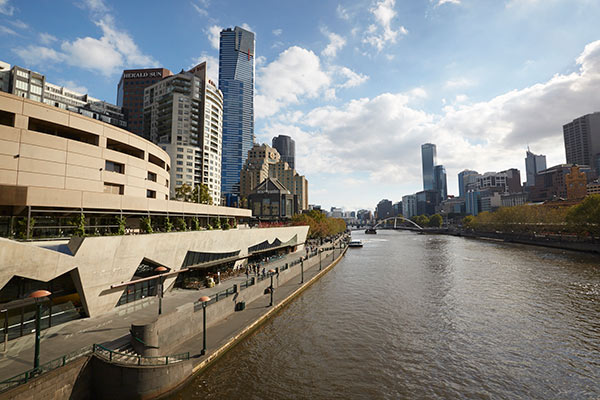
Opened in 1992, Southgate is a reflection of Australia’s arts, food and wine with a distinct Melbourne flavour, as can be traced through the history of the Southbank location itself.
Southgate was always a meeting point on the Yarra River. A waterfall at Princes Bridge protected the fresh water coming downstream while trading ships could navigate upstream from the saltwater of Port Phillip Bay. This conveniently dictated the site of Melbourne.
The south side of the river supported the young city with breweries and food processing, while shipping and trading utilised the docks and warehouses.
Over time, the area consolidated into an industrial district housed in a messy collection of old buildings and vacant government land. By the 1940s the Trocadero dance hall, on the art gallery site, and Glaciarium ice skating rink, where the twin Southgate commercial towers now stand, were lonely leisure activities in the area. The large neon sign on the Allens Confectionery factory was the only landmark.
The National Gallery of Victoria was relocated in the 1960s, the Victorian College of the Arts in the 1970s, and the natural evolution of the district was coaxed by a vision of a rejuvenated waterfront highlighting an expanded educational, cultural and leisure precinct. By the 1980s a co-ordinated government strategy led to the building and landscaping of the south promenade. This encouraged development of major commercial infrastructure. Southgate was born and succeeded all expectations by adding its own character to the area.
For more than 20 years Southgate has been part of the fabric of Melbourne daily life, particularly for the growing number of local residents in the neighbourhood. The urban planning has been carefully designed to encourage explorationand discovery. A deliberate and sophisticated approach reflects the normal organic way a city grows overtime. The boundaries of the 2.4ha Southgate site are integrated into the surroundings. Thus you are naturally led to Hamer Hall, the Arts Centre, National Gallery of Victoria (NGV International), St Johns Church, Langham Hotel, riverside, Southgate office towers, across the road to the Australian Ballet, the ABC headquarters or under Princes bridge to the Alexandra and Botanical gardens and Melbourne’s major sporting facilities.
The Southgate Art Collection
Southgate has always displayed a wide range of artworks as a commitment to the precinct and Melbourne’s well known reputation as Australia’s cultural capital.
In 1992, a number of artworks were commissioned to coincide with the grand opening of Southgate, with the focus of each artwork being the artists’ interpretation of Melbourne. These artworks included Ophelia a large mosaic sculpture by Deborah Halpern.
Ophelia has recently returned to the Southgate promenade after a short time away being carefully restored. You can view more information about Ophelia here.
